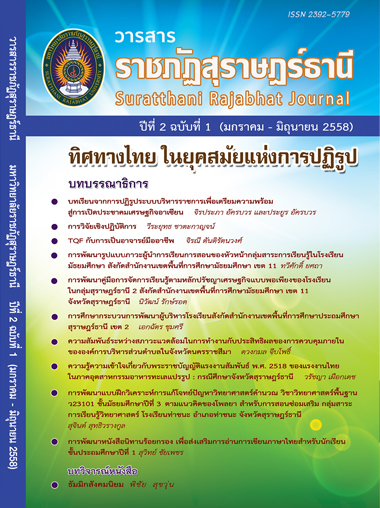การพัฒนาแบบฝกวิเคราะห์การแกโจทยปญหาวิทยาศาสตร์คำนวณ วิชาวิทยาศาสตร์พื้นฐาน ว23101 ชั้นมัธยมศึกษาปีที่ 3 ตามแนวคิดของโพลยา สำหรับการสอนซ่อมเสริม กลุมสาระการเรียนรู้วิทยาศาสตร์ โรงเรียนท่าชนะ อำเภอท่าชนะ จังหวัดสุราษฎร์ธานี
Main Article Content
บทคัดย่อ
การพัฒนาแบบฝกวิเคราะห์การแกโจทยปญหาวิทยาศาสตร์คำนวณวิชาวิทยาศาสตร์พื้นฐาน ว23101ตามแนวคิดของโพลยาชั้นมัธยมศึกษาปีที่ 3 สำหรับการสอนซ่อมเสริมกลุมสาระการเรียนรูวิทยาศาสตร์โรงเรียนท่าชนะอำเภอท่าชนะ จังหวัดสุราษฎร์ธานีเป็นการวิจัยและพัฒนา (Research and Development) มีวัตถุประสงค์ 1)เพื่อสร้างและหาประสิทธิภาพตามเกณฑ 80/80 หาค่าประสิทธิผล (E.I.) และค่าสัมประสิทธิ์การกระจาย(C.V.) 2) เพื่อเปรียบเทียบผลสัมฤทธิ์ทางการเรียนก่อนและหลังการทดลองใช้ระหว่างกลุ่มควบคุมและกลุ่มทดลองที่ใช้แบบฝึกกับการสอนซ่อมเสริมตามปกติ 3) เพื่อเปรียบเทียบผลสัมฤทธิ์ทางการเรียนหลังการทดลองใช้ระหว่างกลุ่มควบคุมและกลุ่มทดลอง 4) เพื่อศึกษาความพึงพอพอใจของนักเรียนที่มีตอแบบฝึกวิเคราะห์การแก้ปัญหาโจทย์ปัญหาวิทยาศาสตร์คำนวณวิชาวิทยาศาสตร์พื้นฐาน ว 23101 ชั้นมัธยมศึกษาปีที่ 3 ตามแนวคิดของโพลยา สำหรับใช้สอนซ่อมเสริม กลุ่มตัวอย่างที่ใช้ในการวิจัยครั้งนี้แบ่งเป็น 2 กลุ่ม คือ กลุ่มควบคุม จำนวน 32 คนและกลุ่มทดลอง จำนวน31 คน ได้มาโดยการสุ่มแบบเฉพาะเจาะจง (Purposive Sampling)มีขั้นตอนการดำเนินงาน 3 ขั้นตอน คือ ขั้นตอนที่1 การสรางและหาประสิทธิภาพ ขั้นตอนที่2การเปรียบเทียบผลสัมฤทธิ์ทางการเรียนก่อนและหลังการทดลองระหว่างกลุ่มควบคุมที่ใช้การสอนซ่อมเสริมตามปกติและกลุ่มทดลองที่ใช้การสอนซ่อมเสริมโดยใช้แบบฝึก ขั้นตอนที่3การศึกษาความพึงพอใจของนักเรียนที่มีตอแบบฝก การวิเคราะห์ข้อมูลโดยการหาค่าประสิทธิภาพของแบบฝึกโดยใช้เกณฑ์ 80/80 หาค่าประสิทธิผล(E.I.) และค่าสัมประสิทธิ์การกระจาย (C.V.) การเปรียบเทียบผลสัมฤทธิ์ทางการเรียนก่อนและหลังเรียนของกลุ่มควบคุมและกลุ่มทดลองโดยการทดสอบค่าที(t-test Dependent for samples) และการทดสอบผลสัมฤทธิ์ทางการเรียนหลังเรียนระหว่างกลุ่มควบคุมและกลุ่มทดลองโดยการทดสอบค่าที และวิเคราะห์ความพึงพอใจของนักเรียนที่มีต่อแบบฝึกโดยใช้ค่าเฉลี่ย () และค่าความเบี่ยงเบนมาตรฐาน (S.D.) ผลการวิจัยพบว่าการสร้างแบบฝกวิเคราะห์การแกโจทย์ปญหาวิทยาศาสตรคำนวณ วิทยาศาสตร์พื้นฐาน ว23101 ชั้นมัธยมศึกษาปีที่ 3 ตามแนวคิดของโพลยา ได้แบบฝึกวิเคราะห์การแก้โจทย์ปัญหาวิทยาศาสตร์คำนวณตามแนวคิดของโพลยา จำนวน 9 เล่ม ได้แก่ โจทยปญหาระยะทางและการกระจัด โจทยปญหาแรงลัพธ์โจทยปญหาความเร็วและอัตราเร็ว โจทยปญหาแรงเสียดทาน โจทยปญหาแรงพยุง โจทยปญหาโมเมนต์ของแรง โจทยปญหางานและกำลัง โจทยปญหาไฟฟ้าเบื้องต้น โจทยปญหาการอ่านค่าตัวต้านทาน ฝึกผลการประเมินความเหมาะสมของแบบฝึกจากผู้เชี่ยวชาญมีความเหมาะสมอยู่ในระดับมาก แบบฝึกมีประสิทธิภาพเท่ากับ 80.39/80.93 มีประสิทธิผล เท่ากับ 0.859 มีค่าสัมประสิทธิ์การกระจายเท่ากับ11.36 การเปรียบเทียบผลสัมฤทธิ์ทางการเรียนก่อนการทดลองการสอนซ่อมเสริมกับการสอนซ่อมเสริมตามปกติ พบว่าค่าเฉลี่ยกลุ่มทดลอง (=12.71) และกลุ่มควบคุม (=11.59) ไม่แตกต่างกัน ที่นัยสำคัญทางสถิติ ที่ระดับ.01 การเปรียบเทียบผลสัมฤทธิ์ทางการเรียนก่อนและหลังการทดลองการสอนซ่อมเสริมโดยใชแบบฝกกับการสอนซ่อมเสริมตามปกติ พบว่าผลสัมฤทธิ์ทางการเรียนของนักเรียนที่เรียนโดยการสอนซ่อมเสริมตามปกติมีคะแนนเฉลี่ยหลังเรียน (=18.94) สูงกวาคะแนนเฉลี่ย กอนเรียน (=11.59)อยางมีนัยสําคัญทางสถิติที่ระดับ.01 และผลสัมฤทธิ์ทางการเรียน ของนักเรียนที่เรียนดวยแบบฝก มีคะแนนเฉลี่ยหลังเรียน (=22.97) สูงกวาคะแนนเฉลี่ย กอนเรียน (=12.71) อยางมีนัยสําคัญทางสถิติที่ระดับ.01การเปรียบเทียบผลสัมฤทธิ์ทาง การเรียนหลังการทดลองการสอนซ่อมเสริมโดยใชแบบฝกกับการสอนซ่อมเสริมตามปกติ พบวาผลสัมฤทธิ์ทางการเรียนของนักเรียนที่เรียนดวยแบบฝก มีคะแนนเฉลี่ยหลังเรียน (=22.97) สูงกวาคะแนนเฉลี่ยหลังเรียน (=18.94) ที่เรียนดวยการสอนซ่อมเสริมตามปกติ อยางมีนัยสําคัญทางสถิติที่ระดับ.01 นักเรียนมีความพึงพอใจที่มีต่อแบบฝึกสำหรับการสอนซ่อมเสริมพบว่านักเรียนมีความพึงพอใจโดยรวมอยู่ในระดับมาก(=4.02)
Article Details
เอกสารอ้างอิง
เกริก ท่วมกลางและดร.จินตนา ท่วมกลาง. (2555).การพัฒนาสื่อ/นวัตกรรมทางการศึกษาเพื่อเลื่อนวิทยฐานะ. กรุงเทพมหานคร : เยลโลการพิมพ์(1988)จำกัด.
กัญญารัตน สรองสิงห. (2549). การพัฒนาชุดฝกทักษะวิชาคณิตศาสตรสําหรับนักเรียนชั้นประถมศึกษาปที่ 4. วิทยานิพนธกศ.ม.ปริญญามหาบัณฑิต บัณฑิตวิทยาลัย มหาวิทยาลัยนเรศวร.
ขันทนา จันทร์ศรี. (2541). การสอนซ่อมเสริมวิชาคณิตศาสตร์ชั้นประถมศึกษาปีที่ 3 โดยใช้ชุดการเรียน. วิทยานิพนธ์ศึกษาศาสตร์มหาบัณฑิตบัณฑิตวิทยาลัย มหาวิทยาลัยเชียงใหม่.
ไพรัช ศีลาเจริญ. (2550). การเปรียบเทียบผลการจัดการเรียนรู เรื่องโจทยปัญหากลุ่มสาระการเรียนรู คณิตศาสตร ของนักเรียนชั้นประถมศึกษาปที่ 4 ที่เรียนโดยใชวิธีสอนตามขั้นตอนการสอนของโพลยากับวิธีสอนตามคูมือการจักการเรียนรู. วิทยานิพนธ ค.ม. บัณฑิตวิทยาลัย มหาวิทยาลัยราชภัฏเทพสตรี.
สถาบันทดสอบทางการศึกษาแห่งชาติ(องค์การมหาชน). (2553). รายงานผลการทดสอบระดับชาติขั้นพื้นฐาน(O-NET)ช่วงชั้นที่ 3 ชั้นมัธยมศึกษาปีที่ 3. กรุงเทพมหานคร: เอกสารอัดสำเนา.
สถาบันทดสอบทางการศึกษาแห่งชาติ(องค์การมหาชน). (2554). รายงานผลการทดสอบระดับชาติ ขั้นพื้นฐาน(O-NET)ช่วงชั้นที่ 3 ชั้นมัธยมศึกษาปีที่ 3. กรุงเทพมหานคร: เอกสารอัดสำเนา.
สถาบันสงเสริมการสอนวิทยาศาสตรและเทคโนโลยี. (2546 ก). การจัดสาระการเรียนรูกลุ่มสาระการเรียนรู้วิทยาศาสตร ชวงชั้นที่ 3-4 หลักสูตรการศึกษาขั้นพื้นฐาน. กรุงเทพมหานคร:กราฟฟค.
สุพัตรา แสงเอี่ยม. (2555). การพัฒนาแบบฝกทักษะการแกโจทยปญหาคณิตศาสตรตามแนวคิดของโพลยาและเทคนิคการวาดรูป บารโ มเดล โมเดลเรื่องการบวก ลบ คูณ และหารกลุมสาระการเรียนรูคณิตศาสตร สําหรับนักเรียนชั้นประถมศึกษาปที่ 4.วิทยานิพนธ์ กศ.ม. บัณฑิตวิทยาลัยมหาวิทยาลัยนเรศวร.
อุษณีย เสือจันทร. (2553). การพัฒนาแบบฝกทักษะแกปญหาทางคณิตศาสตรเรื่องวิธีเรียงสับเปลี่ยนและวิธีจัดหมูกลุ่มสาระการเรียนรูคณิตศาสตรสําหรับนักเรียนชั้นประถมศึกษาปที่ 5. วิทยานิพนธ์ กศ.ม. มหาวิทยาลัยนเรศวร.
Leblance, John F. (1997). You Can Teach Problem Solving. Arithmetic Teacher. 25(2) : 16-20.
Otto, W, R.A.McMenemy and R.J. Smith.(1963). Corrective and Remedial Teaching.Boston :Hanghton Mifflin.
Polya George. (1957). How to Solve It; a New aspect of Mathematic Method. New York : Double Day.


